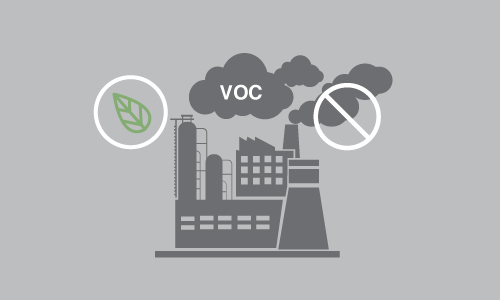Volatile Organic Compounds (VOCs) are generated during a variety of industrial processes such as petroleum refining, metal production, chemical processing, and the manufacturing of consumer and commercial products.
The level of emission, VOC concentration, and exhaust air volume vary depending on the processes and the abatement technologies used.
The Impact of VOC Emission
There are different types of VOCs, many of which are harmful to humans and the environment. They can lead to negative respiratory, allergic, or immune effects such as eye, nose, and throat irritation, headaches, loss of coordination, and nausea. They can also damage the liver, kidneys, and central nervous system. Some are suspected to cause cancer.
In addition, some VOCs react with nitrogen oxides or ozone to produce secondary aerosols, which can lead to other sensory irritation symptoms and the formation of smog.
Strict Emission Standards on VOCs
Due to the various harmful effects, governments worldwide are issuing increasingly strict regulations to control the damages VOCs inflict on humans and the environment.
The US EPA regulates VOCs at the Federal level in 40 CFR 59, which contains VOC emission standards for a variety of consumer and commercial products including architectural, aerosol, and automobile coating.
Meanwhile, the Clean Air Act provides detailed requirements for air pollution, emission, and acid deposit control. In particular, the section on sulfur dioxide and nitrogen oxides control has the most impact on the manufacturing industry. Manufacturers that fail to meet the requirements will face an excess emissions penalty.
Challenges in Meeting VOC Emission Standards
Due to the increasingly strict requirements, it has become more challenging for manufacturers to meet the VOC abatement standards.
Many VOC abatement technologies require the use of intense heat and therefore involve high energy costs. The process also emits a lot of heat, which requires accommodation in the manufacturing plant design. In addition, many outdated VOC systems (e.g., over 7-10 years old) aren’t energy efficient and are therefore costly to operate.
Selecting the Most Cost-Effective VOC Abatement Technologies
There are different types of VOC abatement technologies manufacturers can use. Selecting the appropriate technology will help ensure compliance with the latest emission standards in the most cost-effective way possible:
- Regenerative Thermal Oxidizers (RTOs): The process combines VOCs with oxygen under extreme temperature to induce a chemical reaction that destroys harmful chemicals. The heat emitted can be reused for other purposes.
- Catalytic Oxidizers: Heat is also used to destroy VOCs, but a lower temperature is required compared to RTOs thanks to the use of catalytic oxidizers in the combustion chamber.
- Thermal Recuperative Oxidizers (TOs): Elevated temperature causes oxidation that destroys harmful chemicals as exhaust streams pass through a combustion chamber.
- Rotary Concentrator: Exhaust stream is moved through a rotating wheel in which pollutants are absorbed by a hydrophobic Zeolite media, which are then removed and destroyed by an oxidizer.
Using the right VOC abatement technologies can help you reduce VOC emission and adhere to the strict standards in a cost-effective way. Download our free Air Pollution Control Selection Guide to find the right VOC abatement solution for your manufacturing facility.




